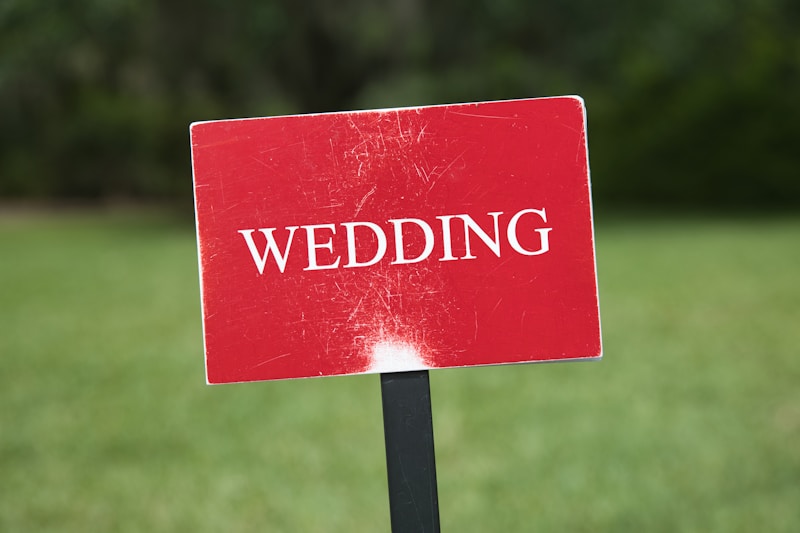Comprehensive Financial Planning for Your Nuptials: A Complete Guide
Understanding Financial Planning for NuptialsWeddings can be one of the most significant and joyous occasions in a person’s life, but the associated costs can be daunting. Proper financial planning for nuptials is essential to ensure a stress-free experience that allows couples to focus on celebrating their love without the constraints of financial worry. In this article, we will guide you through the pivotal aspects of financial planning for nuptials, ensuring that you are well-prepared for your special day.Why Financial Planning for Your Wedding is CrucialFinancial planning plays a key role in transforming a wedding dream into reality. It helps couples allocate their budget, prioritize spending, and make informed financial decisions. Below are some fundamental reasons why financial planning is essential:Budget Management: Establishing a clear budget helps control and limit expenses.Prioritization: Couples can focus on what aspects of the wedding matter most to them.Debt Avoidance: Careful planning can prevent couples from incurring unnecessary debt.Negotiation Power: A well-planned budget enables couples to negotiate better deals with vendors.Key Components of Financial Planning for Your WeddingAs you embark on this exciting journey, consider the following crucial components of financial planning:1. Setting a Realistic BudgetDetermining the overall budget is the first step. Take into account your savings, family contributions, and any potential loans. Here's a simple budget...
Understanding Bridal Gown Spending Habits: A Comprehensive Guide
When it comes to weddings, one of the most significant expenditures is the bridal gown. Women often dream about the perfect dress long before they even get engaged. In this article, we will explore the various bridal gown spending habits among brides, how much they are willing to spend, the factors influencing their decisions, and much more. As we delve into this fascinating topic, we'll also provide insights, statistics, and tips to help future brides make informed decisions about their bridal gown purchases.Bridal Gown Spending: An OverviewAccording to recent studies, the average bridal gown spending has fluctuated over the years, but many brides are willing to invest considerable amounts for that perfect dress. In the United States, the average cost of a bridal gown is approximately $1,800, with prices ranging from $500 to over $5,000 depending on various factors.Factors Influencing Bridal Gown CostsDesigner BrandFabric QualityLocation of PurchaseCustomization OptionsAdditional AccessoriesWedding ThemeThe Psychological Perspective on SpendingUnderstanding the psychological aspect behind spending habits can provide valuable insights into why brides spend as much as they do on bridal gowns. Many brides feel that their gown is a representation of their personality, style, and the significance of the occasion. The emotional connection to their wedding day often drives them to spend more than originally planned. This desire for a memorable experience can lead to overspending, w...
Essential Guide to Avoiding Wedding Budget Pitfalls
Planning a wedding can be a beautiful journey filled with excitement, but it often comes with the challenge of sticking to a budget. In this article, we will explore the common wedding budget pitfalls that couples encounter and provide actionable tips to help you navigate these challenges effectively. From unexpected expenses to emotional decision-making, understanding these potential issues can help you have a seamless and stress-free celebration.Understanding the Importance of a Wedding BudgetA wedding budget serves as a financial blueprint, ensuring you allocate your resources wisely. With the average cost of a wedding in the U.S. reaching approximately $34,000 in 2023, maintaining control over your expenses is crucial. A well-planned budget helps prioritize spending according to your vision while avoiding financial strife. Here are key factors to consider:FactorImportanceVenueOften the largest expense; booking early can save costsCateringQuality food and drink enhance guest experience but can be expensivePhotographyCaptures memories; investing in a good photographer is worthwhileAttireBridal and groom’s attire can vary widely; budget accordinglyDecorSets the atmosphere; DIY options can save moneyCommon Wedding Budget Pitfalls to Avoid1. Ignoring Hidden CostsMany couples overlook hidden costs associated with their planned expenses. For example, when booking a venue, couples often fail to factor in additional fees such as security deposits, cleaning costs, and taxes. These ...
Understanding Attitudes Towards Spending on Wedding Dresses
Weddings are a significant milestone in life, and for many brides, finding the perfect wedding dress is an essential part of the journey. However, attitudes towards spending on wedding dresses vary considerably. This article delves into the factors that influence how much people are willing to spend on wedding dresses, including cultural beliefs, economic conditions, and personal values. We will also explore various trends and preferences among different demographics. The Cultural Perspective on Wedding Dress Spending In many cultures, the wedding dress symbolizes love, commitment, and family heritage. In countries like the United States and the United Kingdom, there is a wide range of wedding dress prices, often influenced by cultural expectations and personal beliefs. For instance, traditional white wedding dresses often command higher prices due to the materials used and the craftsmanship involved. In contrast, in some Asian cultures, colors like red or gold hold significant meaning and can lead to different spending attitudes. Comparative Analysis of Wedding Dress Costs in Different Regions Region Average Spending on Wedding Dresses Common Styles United States $1,500 Traditional white dresses, ball gowns United Kingdom £1,600 Classic designs, modern silhouettes India ₹25,000 Lehengas, sarees, embellished gowns China ¥8,000 Red dresses, qipaos The table above offers a comparative analysis of wedding dress spending in various reg...
The Perceived Value of Wedding Dresses: Understanding What Makes Them Special
When it comes to one of the most significant days in a person's life, the wedding day, everything matters, especially the wedding dress. The perceived value of wedding dresses plays a crucial role in not only how a bride feels but also how her choices are influenced by cultural and social factors. This article aims to explore the multifaceted meanings attached to wedding dresses and how they affect purchasing decisions.What is Perceived Value?The concept of perceived value refers to the worth that an item holds in the eyes of the consumer. It is not merely about the price tag; instead, it encompasses all factors that contribute to the emotional and psychological aspects of ownership. In the case of wedding dresses, perceived value is heavily influenced by brand reputation, quality, societal standards, and emotional significance.Factors Influencing the Perceived Value of Wedding DressesFactorDescriptionBrand ReputationThe recognition and prestige associated with designer labels.Quality of MaterialsThe fabric type, craftsmanship, and details can greatly enhance the dress's value.Social TrendsCurrent fashion trends and celebrity endorsements can affect what brides consider valuable.Emotional AttachmentThe personal story behind the dress can add sentimental value.Cultural Significance of Wedding DressesIn various cultures, the wedding dress carries immense significance. For instance, in Western societies, a white dress symbolizes purity and new beginnings, while in many Asian cul...
Fashion Choices Aligned with Budget Priorities: A Comprehensive Guide
In today’s fast-paced world, the way we approach fashion is increasingly influenced by our budget priorities. Making smart fashion choices doesn't mean sacrificing style; in fact, when done thoughtfully, it can enhance your wardrobe while keeping your finances in check. This article explores how to align your fashion choices with your budget, focusing on strategies to optimize your wardrobe, identify key pieces, and ensure your style reflects your personality without breaking the bank.The Importance of Budgeting in FashionFashion budgeting is essential not just for financial stability but also for making informed choices about what to wear. By recognizing your financial limitations, you can develop a fashion sense that mirrors your lifestyle and personal style without unnecessary spending.Here are the key benefits of budgeting in fashion: Financial Stability: Keeping track of your fashion expenses can prevent debt and promote savings. Clarity on Spending: You’ll have a clearer understanding of where your money goes, helping you prioritize must-have items. More Thoughtful Choices: Budgeting encourages you to think critically about your purchases, leading to better long-term wardrobe investments.Understanding Your Personal StyleBefore making fashion choices aligned with your budget, it’s vital to identify your personal style. Understanding what you love to wear can help you make decisions more easily. Consider the following aspects:Style TypeKey CharacteristicsClassicT...
Exploring Consumer Confidence in Wedding Expenditures: Trends and Insights
As the wedding industry continues to evolve, understanding consumer confidence in wedding expenditures has become increasingly vital for vendors, couples, and researchers alike. With fluctuating economic conditions, every couple's budgeting decisions are influenced by their confidence in their financial future. This article explores the factors affecting consumer confidence in wedding spending and provides key insights and trends to consider.Understanding Consumer ConfidenceConsumer confidence is essentially a measure of how optimistic or pessimistic consumers feel about the overall state of the economy and their personal financial situation. It plays a crucial role in determining how much individuals are willing to spend on non-essential items, such as weddings. Major factors influencing consumer confidence include: Economic stability Employment rates Income growth Inflation ratesImpact on Wedding ExpendituresWith weddings being one of life's pivotal celebrations, expenditure tends to range significantly based on local cultures, trends, and consumer confidence levels. A strong consumer confidence index generally indicates heightened spending on weddings, while a dip in confidence may lead to budget cuts. Here’s a brief overview of how financial outlook influences wedding budgets:Confidence LevelConsumer Spending on WeddingsCommon AdjustmentsHigh$30,000+Luxury venues, extensive guest listsModerate$20,000 - $30,000Mid-range venues, moderate guest listsLowUnder $20,...
Ultimate Guide to Budgeting for Bridal Fashion: Make Your Dream Wedding Dress Affordable
Planning a wedding can be both exciting and stressful, especially when it comes to budgeting for bridal fashion. With the average cost of a wedding dress ranging from $1,500 to over $3,000, it’s essential to create a financial plan that allows you to look stunning without breaking the bank. This article will guide you through the various aspects of budgeting for bridal fashion, ensuring you make informed choices that won’t leave you with financial regret.Understanding the Costs of Bridal FashionWhen thinking about budgeting for bridal fashion, consider all the elements involved. The wedding dress is just one part of the equation. Below are the key components to factor into your budget.ItemAverage CostWedding Dress$1,500 - $3,000Bridesmaids Dresses$150 - $300 eachAccessories (Veils, Jewelry)$100 - $500Shoes$50 - $300Alterations$100 - $600Emergency Kit$50 - $150As you can see, the total costs can add up quickly. Therefore, it's crucial to take a closer look at each category to effectively budget for bridal fashion.Step 1: Set a Realistic BudgetThe first step in budgeting for bridal fashion is to determine how much you can realistically spend. Analyze your overall wedding budget and prioritize various aspects. Ask yourself:What percentage of my total budget should be allocated to my bridal fashion?Are there any expenses I can cut down on in other areas?Am I open to exploring more budget-friendly options?Once you answer these questions, you can set a specific figure to aim for. R...
Understanding Your Financial Commitment to Bridal Wear
Introduction to Bridal Wear FinancingWhen it comes to planning a wedding, one of the significant areas that couples must consider is the financial commitment to bridal wear. The bridal gown is often seen as a centerpiece of the wedding day, representing not only the bride's style but also her financial investment. This article explores the various aspects of financial commitment to bridal wear, including costs, budgeting tips, alternatives, and key considerations before making a purchase.Understanding Bridal Wear CostsThe price range for bridal wear varies significantly, depending on several factors such as designer, fabric, and additional features like customizations and embellishments. Here’s a general breakdown of what you can expect to spend:Type of Bridal WearAverage Cost (USD)Off-the-rack gowns$1,000 - $3,000Designer gowns$3,000 - $10,000+Bridal gowns with custom designs$2,000 - $15,000+Accessories (veil, shoes, lingerie)$200 - $1,000Alterations$150 - $600Establishing a Budget for Bridal WearBefore diving into bridal wear shopping, it’s critical to establish a realistic budget. Here are some tips for creating a budget:Determine Your Total Wedding Budget: Know how much you’re willing to spend on the entire wedding.Research Average Costs: Understand what other brides are spending on bridal wear in your area.Allocate a Percentage: Commonly, brides allocate about 10-15% of their total budget to the wedding dress.The Emotional Impact of Financial Commitment to Bridal WearPur...
Expectations vs. Realities in Bridal Budgeting: A Comprehensive Guide
Introduction to Bridal BudgetingWhen it comes to planning a wedding, effective budgeting is essential for turning dreams into reality. While many couples envision a grand celebration with lavish details, the truth is that financial constraints can often lead to feelings of disappointment. This article explores the critical aspects of expectations vs. realities in bridal budgeting, helping couples navigate their financial journey towards their big day.Understanding Bridal BudgetingBridal budgeting encompasses all costs associated with planning a wedding. From the venue to the flowers, every detail requires careful consideration. Many couples start with high expectations, often influenced by social media, weddings they’ve attended, or celebrity events. However, understanding the actual costs and what they can realistically afford is crucial. Let’s delve into common expectations and the realities that often follow.Common Expectations for a Wedding BudgetExpectationRealityLavish VenueMost couples find themselves limited to local venues that fit within their budget.Designer Wedding DressMany couples opt for off-the-rack dresses or rental options to stay within budget.Full-Service CateringCouples may consider buffet options or food trucks as cost-effective alternatives.Extravagant EntertainmentHiring a DJ instead of a live band can significantly reduce costs.Luxury Floral ArrangementsDIY or simplified arrangements are common to save money.The Real Cost of WeddingsAccording to recen...
The Impact of Psychological Factors on Wedding Dress Selection
Understanding the Psychological Factors in Wedding Dress SelectionChoosing a wedding dress is among the most significant decisions that brides-to-be face during the planning of their big day. Not only does the dress represent personal style and aesthetics, but it also carries deeper emotional and psychological implications. This article delves into the various psychological factors in wedding dress selection, exploring how emotions, culture, and individual psychology play a vital role in this important decision-making process.The Importance of the Wedding DressThe wedding dress is more than just a piece of clothing. It symbolizes the bride's personal identity, aspirations, and even societal expectations. The dress often reflects the couple's love story and their shared values. Understanding these psychological factors is crucial for both brides and wedding planners to help create a meaningful experience.Key Psychological Factors in Wedding Dress SelectionSeveral psychological factors influence a bride’s choice of wedding dress. Below are some of the most significant ones:Psychological FactorDescriptionSelf-ImageBrides want to feel beautiful and confident on their wedding day. The dress should enhance their self-image.Social PressureBrides often face societal expectations about how they should look, which affects their choice of dress.Cultural SignificanceCultural backgrounds influence the style, color, and type of wedding dress brides choose.Emotional ConnectionsThe dress can...
Understanding the Percentage of Wedding Spend: A Comprehensive Guide
IntroductionPlanning a wedding can be one of the most exciting yet overwhelming tasks in life. With numerous elements to consider—from the venue to the guest list and everything in between—understanding the percentage of wedding spend is crucial for creating a realistic budget. This guide provides insights into how much couples typically spend on various wedding components, and how you can allocate your funds wisely.The Importance of Budgeting Your WeddingSetting a budget is essential to prevent overspending and to ensure that your wedding day truly reflects your style and preferences. By breaking down the expenses into percentages, it becomes easier to make informed decisions about where to splurge and where to save. Typical Breakdown of Wedding ExpensesOn average, couples spend around $34,000 on their weddings. However, this amount can vary greatly depending on the location, size, and type of wedding. Here’s a general breakdown of the percentage of wedding spend:Wedding ExpenseTypical Percentage of Total BudgetVenue30%Catering20%Photography/Videography10%Attire (Bride and Groom)10%Flowers8%Music/Entertainment8%Stationery2%Wedding Planner5%Miscellaneous7%Breaking Down Wedding Costs1. Venue (30%)The venue usually takes up the largest chunk of the wedding budget. This includes the cost of renting the space and any additional fees. Depending on the location—whether it's a city-based venue or a picturesque countryside estate—the venue pricing can vary significantly.2. Catering (...
Understanding Consumer Behavior in Wedding Planning: A Comprehensive Guide
IntroductionPlanning a wedding can be both exciting and overwhelming. Understanding consumer behavior in wedding planning is crucial for couples and wedding planners alike. This article will explore the various factors influencing consumer decisions, trends in wedding planning, and effective strategies for navigating the planning process. By comprehending consumer behavior, you can create a memorable and personalized wedding experience.Factors Influencing Consumer Behavior in Wedding PlanningConsumer behavior is influenced by various psychological, social, and economic factors. Below are key elements that play an essential role in wedding planning decisions:FactorDescriptionPsychological FactorsIndividual preferences, attitudes, and emotional factors significantly impact decisions.Social InfluencesFamily, friends, and cultural norms shape expectations and choices.Economic ConstraintsBudget limitations affect the selection of venues, services, and overall planning.Trends and FadsCurrent wedding trends can influence couples' desires, from themes to attire.Psychological FactorsThe psychological aspect of consumer behavior in wedding planning encompasses personal values and emotions. Couples often envision their dream wedding based on their history and emotional ties. A couple's experiences can shape their preferences for themes, colors, and types of ceremonies. For instance, a couple who met at a beach might favor a seaside wedding.Social InfluencesSocial circles and cultural ba...
Bridal Fashion vs. Overall Wedding Budget: Striking the Perfect Balance
Planning a wedding is an exhilarating journey, filled with love, excitement, and endless choices. However, among the myriad of decisions that couples face, perhaps the most challenging is finding the perfect balance between bridal fashion and the overall wedding budget. As you delve into this pressing topic, we'll explore the various factors influencing bridal fashion, the varying costs associated with wedding attire, and how to ensure that your wedding remains within budget while still featuring the wedding dress of your dreams. The Importance of Bridal Fashion Bridal fashion has evolved tremendously over the years, reflecting not just personal style, but also cultural significance and the latest trends. The bride's outfit is often one of the focal points of the entire wedding, signaling her personality and taste. From classic ball gowns to modern minimalist designs, the choices are endless. With so much emphasis placed on bridal fashion, it's crucial to find styles that don't just resonate with your style but also fit comfortably within your financial framework. Key Factors Influencing Bridal Fashion Choices When deciding on bridal fashion, several factors come into play: Personal Style: Choose a style that reflects your unique personality. Are you a traditionalist or a modern fashionista? Theme of the Wedding: The wedding theme can have a significant impact on your dress. For example, a beach wedding may call for a more casual dress compared to a formal church ce...
Savings Strategies for Wedding Attire: Dressing Up Your Big Day on a Budget
Weddings are often considered one of the most special days in a couple's life, but they can also be one of the most expensive. One of the significant expenses couples face is wedding attire. The quest for the perfect dress or suit often comes with a hefty price tag. However, with some smart savings strategies, you can look fabulous while staying within your budget. In this article, we will explore various tips and tricks for saving on your wedding attire, making sure you dazzle without breaking the bank.Understanding the Costs of Wedding AttireBefore diving into savings strategies, it's essential to understand the typical costs associated with wedding attire. A wedding dress can range anywhere from $500 to over $5,000, depending on the designer and fabric. Grooms' suits can also vary significantly in price, typically costing between $300 to $1,500. Accessories, alterations, and undergarments can add an additional $200 to $1,000 to the total cost.ItemAverage CostBudget-Friendly OptionsWedding Dress$500 - $5,000Second-hand, rentalGroom's Suit$300 - $1,500Rental, off-the-rackAccessories$200 - $1,000DIY, borrow from friendsTop Savings Strategies for Wedding Attire1. Set a Realistic BudgetThe first step in saving on wedding attire is to establish a budget. Determine how much you can realistically spend without compromising your financial future. Consider setting aside a specific percentage of your overall wedding budget for attire. This will give you a clear guideline to follow an...
Cultural Influences on Bridal Spending: An In-Depth Analysis
The world of weddings is a tapestry woven with traditions, beliefs, and financial decisions influenced by various cultural factors. Understanding how culture impacts bridal spending can shed light on the choices couples make as they prepare for one of the most important days of their lives. This article delves into the numerous cultural influences on bridal spending, providing insights for couples, wedding planners, and vendors alike.Understanding Cultural InfluencesCultural traditions shape our perceptions and behaviors, particularly during significant life events like weddings. These influences can dictate everything from the type of ceremony to the budget allocated for various elements of the wedding. For example, in some cultures, it is customary for the bride's family to bear most of the wedding costs, while in others, expenses are shared or primarily undertaken by the groom's family. These customs can significantly affect bridal spending.Bridal Spending Across Different CulturesBridal spending can vary tremendously between cultures. Below is a summary of how different cultural practices influence wedding budgets.CultureTypical Bridal Spending InfluencesNotable ExpensesWestern WeddingsIndividualism, emphasis on personal choiceVenue, dress, photographyIndian WeddingsExtravagance, cultural significance of marriageMultiple events, lavish decorationsChinese WeddingsTraditional customs, gift-givingWedding banquet, red envelopesAfrican WeddingsCommunity involvement, vibrant ce...
The Ultimate Guide to Cost-Conscious Bridal Shopping: Tips and Tricks for Budget-Friendly Weddings
IntroductionPlanning a wedding can be exhilarating but also overwhelming, especially when it comes to budgeting. With rising prices and ever-increasing expectations, brides-to-be often find themselves searching for ways to achieve their dream wedding without breaking the bank. This article aims to provide a comprehensive guide to cost-conscious bridal shopping, offering tips, tricks, and alternatives that can help you manage your costs effectively while still enjoying a beautifully orchestrated event.Understanding the Wedding BudgetBefore diving into cost-saving strategies, it's essential to set a realistic wedding budget. On average, weddings cost around $28,000 in the United States, but this can vary dramatically based on location, guest count, and individual preferences. Consider the following components when creating your budget:Expense TypeAverage CostVenue$10,000Catering$7,000Photography$2,000Attire$2,500Flowers$2,000Entertainment$1,500Other$1,000Having a clear budget helps you prioritize your spending and identify where you can afford to cut costs.Where to Save: Smart Strategies for Bridal Shopping1. Dress Shopping on a BudgetThe bridal gown is often one of the most expensive parts of a wedding. However, it doesn’t have to be. Consider these tips for cost-conscious bridal shopping when it comes to your dress:Sample Sales: Bridal shops often have sample sales where you can find high-quality gowns at discounted prices.Second-hand Options: Websites like Stillwhite or PreO...
Planning for the Unexpected Costs in Weddings: Your Ultimate Guide
IntroductionWeddings are often a monumental event in a couple’s life, filled with joy, love, and celebration. However, amidst all the excitement, planning for a wedding can be an overwhelming task, especially when it comes to budgeting. One of the most crucial aspects of wedding planning is preparing for those unexpected costs that can arise. In this article, we will explore various elements to consider when planning for unexpected wedding expenses, ensuring that your special day goes as smoothly as possible.The Importance of a Wedding BudgetCreating and sticking to a wedding budget is essential for managing your finances effectively. The average wedding in the United States costs around $34,000, according to recent statistics. However, it's not uncommon for couples to exceed their initial budgets due to unforeseen costs. These unexpected expenses can emerge from various factors, ranging from vendor fees to last-minute changes. By planning for these potential financial surprises, you can ensure a stress-free wedding experience.Common Unexpected Wedding CostsTo successfully plan for unexpected costs, it’s essential to understand what these costs might be. Below are some common unforeseen expenses that couples encounter:Vendor Overages: Sometimes, caterers, florists, or photographers may charge more than initially quoted.Extra Guests: Last-minute guest additions can increase food and seating costs significantly.Weather-Related Expenses: If you’re having an outdoor wedding, you ...
Affordable Wedding Inspirations: Creative Ideas for Your Perfect Day
Planning a wedding can be an overwhelming task, especially when it comes to budgeting. Many couples look for affordable wedding inspirations to help them create the wedding of their dreams without breaking the bank. In this article, we will explore various creative ideas that can make your wedding both beautiful and cost-effective. From venue choices to DIY decor and budget-friendly catering options, we have you covered. Understanding the Essentials of Affordable Weddings When planning an affordable wedding, it’s important to prioritize your spending. Here are some essentials you should consider: Wedding EssentialsBudget-Friendly Options VenueLook for local parks, community halls, or backyards. CateringConsider a potluck-style reception or food trucks. DecorDIY decorations using thrifted materials or rented items. CakeOpt for a smaller cake and a dessert table. PhotographyHire a student photographer or ask friends. Choosing the Right Venue The venue is one of the biggest expenses in wedding planning. However, there are many affordable wedding inspirations to help you save money. Consider venues such as local parks, community centers, or even your own backyard. These locations often come at minimal cost and provide a beautiful, natural setting for your ceremony and reception. Creative Decorations on a Budget Decorations can add a personal touch to your wedding while also being a significant item on your budget. Here are some ideas to create a beautiful atmo...
Understanding the Psychological Triggers of Pricing in Weddings
Introduction to Wedding Pricing PsychologyWeddings are not just celebrations; they are significant life events that come with emotional weight, financial implications, and, most importantly, the psychology of pricing. Understanding the psychological triggers behind wedding pricing can help couples make informed decisions while staying within their budgets. In this article, we will explore how pricing strategies influence perceptions and decisions in wedding planning, as well as provide practical advice for couples navigating this complex landscape.The Emotional Connection to Wedding CostsEvery couple wants their wedding day to be unique and memorable. This desire often leads to emotional spending, driven by the fear of missing out on the perfect experience. Psychological triggers play a crucial role in shaping these spending habits. Here are several key psychological factors that influence wedding pricing:Psychological TriggerExplanationScarcityA limited supply of a particular service or product can create urgency, making couples more likely to spend money.Social ProofWhen couples see other weddings with extravagant spending, they may feel pressured to conform, leading to higher budgets.AnchoringThe initial price presented often serves as a reference point, influencing how couples perceive the value of other services.ReciprocityCouples may feel obliged to treat their guests with lavish experiences and gourmet meals, inflating the overall cost.Using Pricing Strategies to Creat...
